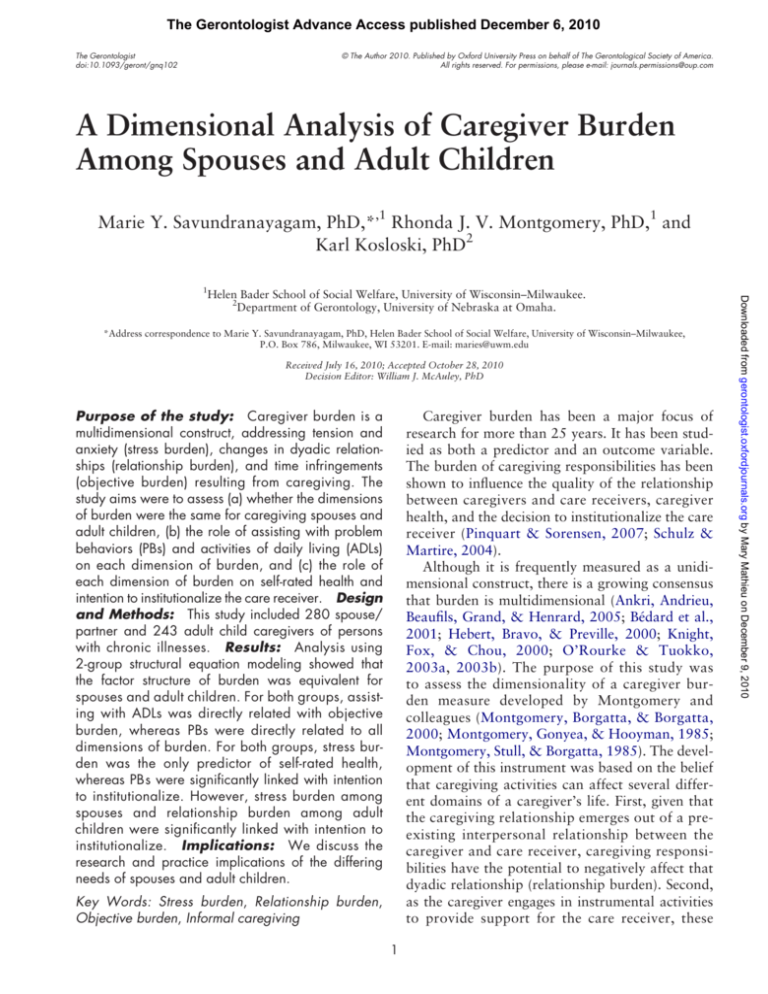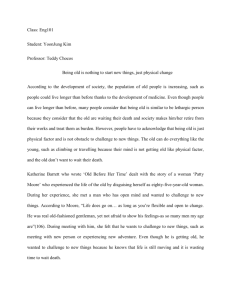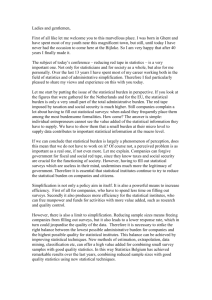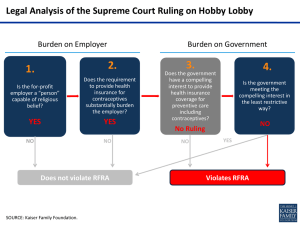
The Gerontologist Advance Access published December 6, 2010
The Gerontologist
doi:10.1093/geront/gnq102
© The Author 2010. Published by Oxford University Press on behalf of The Gerontological Society of America.
All rights reserved. For permissions, please e-mail: journals.permissions@oup.com
A Dimensional Analysis of Caregiver Burden
Among Spouses and Adult Children
Marie Y. Savundranayagam, PhD,*,1 Rhonda J. V. Montgomery, PhD,1 and
Karl Kosloski, PhD2
1
*Address correspondence to Marie Y. Savundranayagam, PhD, Helen Bader School of Social Welfare, University of Wisconsin–Milwaukee,
P.O. Box 786, Milwaukee, WI 53201. E-mail: maries@uwm.edu
Received July 16, 2010; Accepted October 28, 2010
Decision Editor: William J. McAuley, PhD
Purpose of the study: Caregiver burden is a
multidimensional construct, addressing tension and
anxiety (stress burden), changes in dyadic relationships (relationship burden), and time infringements
(objective burden) resulting from caregiving. The
study aims were to assess (a) whether the dimensions
of burden were the same for caregiving spouses and
adult children, (b) the role of assisting with problem
behaviors (PBs) and activities of daily living (ADLs)
on each dimension of burden, and (c) the role of
each dimension of burden on self-rated health and
intention to institutionalize the care receiver. Design
and Methods: This study included 280 spouse/
partner and 243 adult child caregivers of persons
with chronic illnesses. Results: Analysis using
2-group structural equation modeling showed that
the factor structure of burden was equivalent for
spouses and adult children. For both groups, assisting with ADLs was directly related with objective
burden, whereas PBs were directly related to all
dimensions of burden. For both groups, stress burden was the only predictor of self-rated health,
whereas PBs were significantly linked with intention
to institutionalize. However, stress burden among
spouses and relationship burden among adult
children were significantly linked with intention to
institutionalize. Implications: We discuss the
research and practice implications of the differing
needs of spouses and adult children.
Caregiver burden has been a major focus of
research for more than 25 years. It has been studied as both a predictor and an outcome variable.
The burden of caregiving responsibilities has been
shown to influence the quality of the relationship
between caregivers and care receivers, caregiver
health, and the decision to institutionalize the care
receiver (Pinquart & Sorensen, 2007; Schulz &
Martire, 2004).
Although it is frequently measured as a unidimensional construct, there is a growing consensus
that burden is multidimensional (Ankri, Andrieu,
Beaufils, Grand, & Henrard, 2005; Bédard et al.,
2001; Hebert, Bravo, & Preville, 2000; Knight,
Fox, & Chou, 2000; O’Rourke & Tuokko,
2003a, 2003b). The purpose of this study was
to assess the dimensionality of a caregiver burden measure developed by Montgomery and
colleagues (Montgomery, Borgatta, & Borgatta,
2000; Montgomery, Gonyea, & Hooyman, 1985;
Montgomery, Stull, & Borgatta, 1985). The development of this instrument was based on the belief
that caregiving activities can affect several different domains of a caregiver’s life. First, given that
the caregiving relationship emerges out of a preexisting interpersonal relationship between the
caregiver and care receiver, caregiving responsibilities have the potential to negatively affect that
dyadic relationship (relationship burden). Second,
as the caregiver engages in instrumental activities
to provide support for the care receiver, these
Key Words: Stress burden, Relationship burden,
Objective burden, Informal caregiving
1
Downloaded from gerontologist.oxfordjournals.org by Mary Mathieu on December 9, 2010
Helen Bader School of Social Welfare, University of Wisconsin–Milwaukee.
2
Department of Gerontology, University of Nebraska at Omaha.
burden but could also be invaluable to case managers
responsible for linking caregivers with supportive
services. The identification of particular avenues of
distress can help care mangers strategically select
and target available resources to alleviate the specific
types of burden experienced by a caregiver.
In addition to capturing multiple dimensions of
burden, however, an adequate measure must also
reflect the same underlying phenomenon in different populations in the same way. For instance,
because spouses and adult children have been
shown to comprise distinct populations of caregivers,
it is important to know whether the relationships
between the predictors and consequences of burden are invariant across these populations. Given
the differing life circumstances that characterize
these caregivers, the generalizability of findings
cannot simply be assumed.
Findings are reported here from a study
undertaken to examine the measurement pro­
perties and utility of the Montgomery–Borgatta
Burden Measure ( Montgomery, Gonyea, et al.,
1985; Montgomery, Stull, & Borgatta, 1985;
Montgomery et al., 2000), which is being widely
adopted for use in both research and practice
settings (Farley, Demers, & Swaine, 2008;
Savundranayagam, Hummert, & Montgomery,
2005; Savundranayagam, Montgomery, Kosloski, &
Little, 2010; Stone & Clements, 2009). The burden
measure is currently being used as part of caregiver
assessment protocols statewide in Washington
and Georgia and is being used in demonstration
projects in Minnesota and Michigan. Importantly, it assesses the caregiver’s perception that
their caregiving responsibilities are interfering with
their daily life and other responsibilities (objective
burden), strain in the relationship between caregiver and care receiver (demand or relationship
burden), and stress and anxiety (stress burden).
Our first aim was to assess whether the factor
structure of the dimensions of burden and the
relationship between variables were equivalent
across samples of spouses and adult children,
the two groups that comprise the majority of the
population of caregivers. The second aim was
to examine the relationship between the three
dimensions of burden and two important predictor variables—assisting with ADLs and dealing
with PBs. The final objective was to investigate
how each of dimensions of burden is related to
two important caregiver outcomes—self-rated
health and the intention to institutionalize the
care receiver.
2
The Gerontologist
Downloaded from gerontologist.oxfordjournals.org by Mary Mathieu on December 9, 2010
activities can interfere with other aspects of his or
her life, such as relationships with other family
members, work responsibilities, or personal privacy
(objective burden). Third, the caregiving experience can lead to emotional stress or anxiety (stress
burden). It is not uncommon for a caregiver to
experience burden in all these domains nor is it
uncommon for caregivers to experience burden in
at least one or two of these domains.
The multidimensionality of burden means that
any global measure of burden may not adequately
reflect the individual domains of burden, and
therefore, such measures may fail to reveal significant levels of distress for many caregivers. Therefore, in addition to demonstrating that a burden
measure is multidimensional, it is also necessary to
show that the individual domains matter uniquely.
That is, that the domains provide information that
is not reflected in the global composite score.
One way to establish the dimensionality of burden
is to relate the differing dimensions to relevant
external criteria (Carmines & Zeller, 1979). In
other words, if the different dimensions of burden
actually represent different aspects of the caregiving
experience, then their relationships to an external
variable should be different as well. For example,
providing assistance with tasks involving activities
of daily living (ADLs) has been linked to greater
objective burden, whereas providing assistance
with problem behaviors (PBs) was linked with all
three dimensions of burden in a sample of caregiving spouses (Savundranayagam & Montgomery,
2010).
In a similar fashion, the dimensions of burden
must also differentially affect key outcomes. Two
important and frequently examined outcomes are
the caregiver’s health and the caregiver’s intention
to institutionalize the care receiver. Existing research
suggests that the physical health of the caregiver
is compromised when caregivers were psychologically distressed (Pinquart & Sorensen, 2007;
Schulz & Beach, 1999; Schulz & Martire, 2004;
Schulz, O’Brien, Bookwala, & Fleissner, 1995).
Caregiver stress was also a predictor of nursing
home placement in longitudinal studies (Gaugler,
Kane, Kane, Clay, & Newcomer, 2003; Gaugler,
Kane, Kane, & Newcomer, 2005; Gaugler et al.,
2000; Spillman & Long, 2009) as were PBs (Asada,
Kinoshita, & Kakuma, 2000; Gaugler et al., 2003;
Zhu et al., 2006). Knowledge of the relationships
between the different dimensions of burden and
important predictor and outcome variables is not
only critical to establishing the dimensionality of
Methods
Table 1. Description of the sample
Participants and Procedure
Spouses
(N = 280)
Caregiver average age and
63 (24–91)
range (years)
Care recipient average age and 67 (21–100)
range (years)
Caregiver gender (%)
Male
23.6
Female
76.4
Caregiver ethnicity (%)
White
91.0
African American
4.0
Hispanic
3.0
Other
3.0
Caregiver’s level of education (%)
Grades 0–8
0.4
Grades 9–11
3.9
High school graduate
13.6
Some college or associate/
33.9
technical degree
Bachelor’s degree
27.1
(BS, BA, etc.)
Graduate degree or above
21.1
Caregiver employment (%)
Full time
16.5
Part time
14.9
Retired but working
9.1
part time
Fully retired
38.0
Homemaker
12.4
Unemployed
2.5
Other
6.6
Caregiving length (%)
Less than 6 months
1.1
6–12 months
6.5
13–24 months
9.0
25 months to less than
30.7
5 years
5 years or more
52.7
Assistance with activities of
13.74 (16.53)
daily living (mean, SD)
Care receiver’s problem
.75 (.49)
behaviors (mean, SD)
Caregiver burden (mean, SD)
Stress
3.84 (.81)
Relationship
3.05 (.87)
Objective
4.37 (.66)
Self-rated health (mean, SD)
Perceived health
3.69 (.80)
Health compared with others 3.19 (.96)
Satisfaction with health
2.79 (.72)
Intention to institutionalize
1.55 (.81)
(mean, SD)
Adult children
(N = 243)
52 (23–71)
81 (34–101)
12.1
87.9
77.0
8.0
5.0
9.0
0
0.8
11.6
31.0
33.5
23.1
39.6
15.4
4.4
11.0
9.9
12.1
7.7
5.4
11.3
14.6
32.6
36.0
8.17 (13.20)
.73 (.52)
3.69 (.92)
3.07 (.91)
4.18 (.89)
3.72 (.90)
3.07 (1.12)
2.63 (.87)
1.80 (.93)
provided care for 5 or more years compared with
36% of adult children.
The average age was 67 and 81 years for spouse
and parent care receivers, respectively. Both spouse
and adult child caregiver self-report assessments
3
Downloaded from gerontologist.oxfordjournals.org by Mary Mathieu on December 9, 2010
Participants were 280 spouse/partner and 243
adult child caregivers of persons with chronic
illnesses. All participants belong to the League of
Experienced Family Caregivers (LEFC), a registry
of family caregivers who volunteered to help others
by sharing their caregiving experiences. The LEFC,
which is housed in the Office of Applied Gerontology at University of Wisconsin–Milwaukee’s Helen
Bader School of Social Welfare, was created as
part of a larger research effort aimed at developing
and testing measures of caregiving experiences.
A two-step recruitment process was used. Initially,
key staff from more than 100 provider organizations in six states including Area Agencies on
Aging, home health agencies, and chapters of the
Alzheimer’s Association were contacted and informed
about the study effort. These staff members were
asked to share information and distribute brochures to family caregivers with whom they work.
Information and brochures were also distributed
at caregiver conferences and support groups. Caregivers interested in participating provided contact
information to the study team by returning a
postcard that was attached to the brochure. Staff
from the study team then contacted caregivers to
provide detailed information about the registry
and gained informed consent. Caregivers chose
to complete one or more questionnaires online, via
mail, or by telephone. Four percent of participants
responded via phone, whereas 60% responded via
mail and 36% responded via a web-based questionnaire. Questions were included about demographic
characteristics of the caregivers and their family
members with chronic illnesses, the care receiver’s
functional status, and PBs. Family members were
also asked about their own health, the level and
types of care they provided, their level of burden,
and their intention to institutionalize their family
member in a nursing home.
The characteristics of the study samples are
shown in Table 1. The average age of caregivers
was 63 years for spouses and 52 for adult children.
Most caregivers were female who comprised 76%
of spouses and 88% of adult children. As would
be expected, most spouse caregivers were retired,
whereas most adult child caregivers were working
full time. Most participants in this sample were
experienced caregivers, with more than 30%
having provided care for 2–5 years in both groups.
However, more than half of spouse caregivers had
Measures
Assistance With ADLs.—This construct was
measured by asking participants to estimate the
number of hours per week that they spent assisting
their family members with ADLs, such as bathing,
feeding, dressing, and toileting.
Problem Behaviors.—PB was measured with a
15-item inventory that included 14 items developed
by Pearlin and colleagues (1990) and a question
regarding wandering, which is a significant problem
among persons with Alzheimer’s disease. Caregivers
rated how frequently they dealt with each of the
behaviors using the response categories: 0 days,
1–2 days, 3–4 days, and 5/more days. Examples of
items include the number of days the caregiver had
to deal with restlessness, suspiciousness, and irritability on the part of the care receiver. Cronbach’s
alpha for this measure was .80 for spouses and .84
for adult children in the present study.
Self-rated Health.—Self-rated health was measured using three items that asked participants to
rate their (a) overall health at the present time on
a 5-point Likert scale with 1 representing “very
poor” and 5 representing “very good,” (b) health
compared with other people of the same age and
sex on a 5-point Likert scale with 1 representing
“a lot worse” and 5 representing “much better,”
and (c) satisfaction with their health on a 4-point
Likert scale with 1 representing “not satisfied
at all” and 4 representing “completely satisfied”
(DeSalvo, Bloser, Reynolds, Jiang, & Muntner,
2006; Idler & Benyamini, 1997). Cronbach’s alpha
for self-rated health was .86 for spouses and .89
adult children.
Caregiver Burden.—Stress, relationship, and
objective burden were measured using the Montgomery and colleagues (2000) burden measure (see
Appendix). Respondents indicated the extent to
which various aspects of their lives had changed
due to caregiving. Caregivers responded to the
question “As a result of assisting the care receiver,
have the following aspects of your life changed?”
This was followed by the stem: “Have your caregiving responsibilities . . . ”. Response options
were on a five-point Likert scale with 1 representing “not at all” and 5 representing “a great deal”.
“Stress burden” includes five items that measure
the perceived effects of caregiving on affect, such
as anxiety and depression. Caregivers were asked
whether their caregiving responsibilities “made you
nervous,” “depressed you,” “caused you to worry,”
“created a feeling of hopelessness,” and “made you
anxious.” Cronbach’s alpha for stress burden was
.86 for spouses and .90 for adult children.
“Relationship burden” includes five items that
capture the extent to which the care recipient’s
behavior is perceived by the caregiver to be manipulative or overly demanding. Caregivers were asked
whether their caregiving responsibilities “increased
Intention to Institutionalize.—Intention to institutionalize was measured using a single item that
asked participants the likelihood of placing their
relative in a different type of care setting, such as a
nursing home, given the relative’s current condition. The question offered four options ranging
from “definitely not” to “definite would” place in
a different type of care setting.
Analyses Plan
Two-Group Structural Equation Modeling.—
Measurement model. Prior to testing whether
the hypothesized structural models fit the data,
the measurement properties of the latent variables
4
The Gerontologist
Downloaded from gerontologist.oxfordjournals.org by Mary Mathieu on December 9, 2010
attempts by your relative to manipulate you,”
“increased unreasonable requests made by your
relative,” “made you feel taken advantage of by
your relative,” “caused you to feel that your relative makes demands over and above what he/she
needs,” and “caused conflicts with your relative.”
Cronbach’s alpha for relationship burden was .87
for spouses and .89 for adult children.
“Objective burden” includes six items that measure the extent to which care relationships impose
on observable aspects of a caregiver’s life, such as
time for self and others. The objective burden items
ask if caregiving responsibilities have “decreased
time you have to yourself,” “given you little time
for friends and relatives,” “caused your social life
to suffer,” “changed your routine,” “left you with
almost no time to relax,” and “kept you from
recreational activities.” Cronbach’s alpha for
objective burden was .85 for spouses and .93 for
adult children.
indicated that approximately 80% of care receivers
had cognitive or memory problems, with approx­
imately 40% being diagnosed with probable
Alzheimer’s disease/dementia.
were examined for each group separately. The
latent constructs for assisting with ADLs and
intention to institutionalize were composed of single indicators. All other constructs were composed
of multiple indicators using items listed in the
measures section, with the exception of problem
behavior. The indicators for problem behavior, a
latent construct, included three random parcels
with items corresponding to each measure. Parceling
is appropriate when the measure is unidimensional as in the case of problem behavior (Little,
Cunningham, Shahar, & Widaman, 2002). Each
parcel was created using the mean of randomly
chosen items from the measure of problem behavior. These parcels contain approximately equal
common factor variance (Little et al., 2002). The
scale was set using the effects-coded method, where
the indicator loadings average 1.0 (Little, Slegers, &
Card, 2006). Prior to analyses, all measured variables were converted to percent of maximum
scores, where each indicator was divided by the scale
maximum. This type of scoring has a meaningful
interpretation in that the mean of the construct is
the mean percent of the maximum value.
Evaluating model fit. Parameters were estimated
using maximum likelihood because it yields optimal parameter estimates with continuous multivariate normally distributed variables (Jöreskog &
Sörbom, 1993). Model fit was evaluated by: chisquare goodness-of-fit index, Tucker–Lewis Index,
root mean square error of approximation (RMSEA),
and comparative fit index (CFI).
Results
Measurement Model
Testing for invariance. After testing the fit of
the measurement models for spouses and adult
children separately, the two samples were combined to test for configural and metric invariance
(Meredith, 1993). Confirmation of configural
invariance would indicate that the pattern of free
and fixed parameter estimates was the same across
the two groups. A determination of metric invariance would indicate that the factor loadings and
intercepts of the indicators on the latent variables
were the same across the two groups. Obtaining
invariance of indicator intercepts indicates that the
factor structure of all latent constructs is equivalent for spouses and adult children and that any
group differences should be found at the latent
level.
Nested models. Nested models were created
by placing constraints on previous models using
a model -trimming approach, which begins with a
just-identified model with equal numbers of known
variances/covariances relative to unknown parameters (Kline, 1998). Based on modification indices,
paths were removed from the hypothesized model
until there was a significant chi-square difference
signifying that the more parsimonious model
provided the best fit to the data.
5
Downloaded from gerontologist.oxfordjournals.org by Mary Mathieu on December 9, 2010
The first study objective was to assess whether
the latent constructs for burden were the same
across spouses and adult children. To meet this
objective, we examined the measurement model
using a two-group mean and covariance structures model. The modification indices in the
initial configural model suggested that one set of
correlated errors be added for items belonging to
stress burden: between “made you nervous” and
“made you anxious.” Two sets of correlated
errors were also added for items belonging to
objective burden. These were added for the two
items “kept you from recreational activities” and
“caused your social life to suffer” and the two
items “decreased time you have to your self” and
“changed your routine.” These correlated errors
seemed reasonable because each pair belonged to
the same type of burden. As reported in Table 2,
models (2 and 3) that were used to test for strong
metric invariance (i.e., the loadings and intercepts were constrained to be invariant across
groups) showed no significant changes in fit based
on both the RMSEA model test (Little, 1997) and
differences in CFI (Cheung & Rensvold, 2002).
This indicated that the three dimensions of burden and all other constructs in the model have
the same factor structure for spouses and adult
children. Moreover, it allows for the test of
group differences in the relationships identified
by the hypothesized structural model (Figure 1).
Table 3 presents the loading, intercept, residual,
and squared multiple correlation values for
each indicator as well as the variance for each
latent construct in the strong metric invariant
model.
We also tested for differences in the variances
and covariances of the latent constructs between
for the samples for spouses and adult children and
determined that there were significant group differences. Analyses for the two groups, therefore,
were conducted separately.
Table 2. Comparison of nested models for two-group structural equation modeling testing the hypothesized model
Model
Configural invariance
a
Loadings invariance
Intercepts invariancea
Invariance of variances/
covariancesb
Hypothesized modelb
Final modelb
c2
df
p
RMSEA (90% CI)
TLI
746.58
764.70
810.20
823.44
460
477
494
503
<.001
<.001
<.001
<.001
0.0449 (0.0382–0.0515)
0.0441 (0.0374–0.0506)
0.0451 (0.0386–0.0514)
0.0461 (0.0398–0.0523)
0.979
0.98
0.979
0.979
CFI
Dc2
Ddf
p
0.983
0.983
0.981
0.981 58.75 26 <.005
826.51 504 <.001 0.0451 (0.0386–0.0513) 0.979 0.981 16.31 10 >.05
829.51 510 <.001 0.0447 (0.0382–0.0509) 0.979 0.981 19.31 16 >.10
Constraint tenable
Yes
Yes
No
Yes
Yes
Notes: CFI = comparative fit index; CI = confidence interval; RMSEA = root mean square error of approximation;
TLI = Tucker–Lewis Index.
a
Evaluated with RMSEA model test.
b
Evaluated with the c2 difference test.
was significant associated with objective burden,
whereas problem behavior was significant associated
with of all three dimensions of burden. This pattern
was the same for spouses and adult children.
The hypothesized structural model was tested
to address Objectives 2 and 3 of our study, which
relate to predictors and outcomes of caregiver burden. The chi-square difference between the model
with strong metric invariance and the hypothesized
model indicated no significant loss in fit. Non
significant regression paths were removed one at a
time (beginning with the least significant path) to
develop a more parsimonious final model. Model
fit was reevaluated, and the chi-square difference
between the hypothesized and final model indicated no significant loss in fit. Figures 2 and 3
report the results of the final model for spouses
and adult children, respectively.
Correlates of Self-rated Health and Intention to
Institutionalize.—For both groups, stress burden
was the only construct that was significantly
associated with self-rated health, and problem
behaviors were significantly linked with intention
to institutionalize. There were, however, notable
group differences in the dimensions of burden that
were significantly linked with intention to institutionalize. Stress burden was a significant predictor
variable among spouses, whereas relationship
burden was a significant predictor variable only
among adult children. In this sample, objective
burden was not significantly linked with self-rated
health or intention to institutionalize.
Associations Between Predictors Variables and
Burden.—As hypothesized, assistance with ADLs
Stress
Burden
Hours on
Care Tasks
Objective
B d
Burden
Self-rated
H lh
Health
Problem
Behaviors
B
h i
Relationship
Burden
Intent to
Place
Figure 1. Hypothesized two-group structural equation model.
6
The Gerontologist
Downloaded from gerontologist.oxfordjournals.org by Mary Mathieu on December 9, 2010
Structural Model: Predictors and Outcomes of
Burden
Table 3. Loading and intercept values, residuals, and R2 values for indicators in strong metric invariance model
Equated estimates
Indicator
Adult children
Loading (SE)
Intercept (SE)
0.98 (0.03)
1.06 (0.03)
0.97 (0.03)
−0.02 (0.01)
−0.03 (0.01)
0.04 (0.01)
0.82
0.84
0.77
0.35
0.27
0.43
0.65
0.73
0.57
0.31
0.31
0.38
0.69
0.68
0.62
1.00 (0.04)
1.07 (0.03)
−0.01 (0.02)
−0.07 (0.02)
0.74
0.82
0.44
0.36
0.56
0.64
0.45
0.28
0.55
0.72
1.13 (0.03)
−0.15 (0.02)
0.85
0.26
0.74
0.28
0.72
0.94 (0.03)
0.87 (0.04)
−0.06 (0.02)
0.08 (0.03)
0.77
0.68
0.42
0.56
0.58
0.44
0.41
0.52
0.59
0.48
0.81 (0.03)
1.03 (0.03)
1.18 (0.03)
0.76 (0.03)
1.14 (0.04)
0.21 (0.03)
−0.03 (0.03)
−0.18 (0.03)
0.26 (0.03)
−0.16 (0.03)
0.74
0.79
0.82
0.71
0.81
0.53
0.45
0.45
0.58
0.48
0.46
0.55
0.55
0.42
0.52
0.38
0.31
0.23
0.43
0.22
0.62
0.69
0.77
0.57
0.78
1.08 (0.04)
−0.12 (0.03)
0.74
0.58
0.42
0.33
0.67
1.13 (0.04)
0.92 (0.04)
1.11 (0.03)
1.02 (0.03)
0.83 (0.04)
−0.12 (0.03)
0.02 (0.03)
−0.09 (0.03)
−0.03 (0.02)
0.22 (0.03)
0.81
0.67
0.84
0.77
0.72
0.38
0.62
0.31
0.44
0.53
0.62
0.38
0.69
0.56
0.47
0.31
0.46
0.27
0.39
0.44
0.69
0.54
0.73
0.61
0.56
0.90 (0.03)
1.04 (0.03)
1.06 (0.03)
0.13 (0.02)
−0.08 (0.02)
−0.04 (0.02)
0.86
0.81
0.86
0.31
0.37
0.27
0.69
0.63
0.73
0.21
0.32
0.24
0.79
0.68
0.76
2
2
q
R
q
R
Notes: PB = problem behavior.
a
Common metric completely standardized solution.
Discussion
of the caregiving experience that can reliably be
used to assess caregivers’ situations and guide the
allocation of support services. Hence, findings
reported here are important for both researchers
and service providers in that they demonstrate
the importance of measuring specific dimensions
of burden and they explain more fully the impact
of the caregiving experience on family members.
Over the past three decades, a vast literature
has emerged documenting the distressing impact
of caregiving and advocating for interventions to
support family caregivers. The topic has persisted
as a focus for researchers who have generated an
impressive body of literature documenting the
diversity and complexity of the caregiving experience (Dilworth-Anderson, Williams, & Gibson,
2002; Gaugler & Teaster, 2006; Montgomery,
Rowe, & Kosloski, 2007). With the introduction
of the National Family Caregiver Program in 2000
and more recent recognition by policy makers of
the importance of family caregivers, providers of
health and social services have been challenged
to efficiently use scarce resources to support this
diverse and growing population. To meet this challenge, service providers have sought valid measures
Implications for Future Research
The demonstration of strong metric invariance
across the samples of caregiving spouses and adult
children in the measurement of stress burden, relationship burden, and objective burden and metric
invariance for the other latent constructs in the
model is important for several reasons. Not only
do the findings support the contention that caregiver burden is multidimensional but also the
7
Downloaded from gerontologist.oxfordjournals.org by Mary Mathieu on December 9, 2010
PB
PBa
PBb
PBc
Relationship burden
Increased attempts to manipulate you?
Increased number of unreasonable
requests?
Makes demands over and above
what’s needed?
Felt taken advantage of by relative?
Caused conflicts with your relative?
Objective burden
Decreased time you have to yourself?
Kept you from recreational activities?
Caused your social life to suffer?
Changed your routine?
Given you little time for friends/
relatives?
Left you with almost no time to relax?
Stress burden
Created a feeling of hopelessness?
Made you nervous?
Depressed you?
Made you anxious?
Caused you to worry?
Self-rated health
Perceived health
Health compared with others
Satisfaction with health
Spouses
Standardized
loadinga
Stress
Burden
.35
Hours on
Care Tasks
.29
-.39
.48
Objective
Burden
.07 (n.s.)
Self-rated
Health
.34
.17
.32
Problem
Behaviors
.08 (n.s.)
.15
.52
Relationship
Burden
.06 (n .s .)
Intent to
Place
Figure 2. Final model for spouse caregivers. Note: All parameter estimates are standardized and significant, unless otherwise
stated.
Insights Regarding Differential Impacts of Caregiving Responsibilities
findings provide solid evidence of the invariance of
the three dimensions of burden across spouses and
adult children. These results affirm the appropriateness of using the burden measures to make
comparisons between the two groups in terms of
the level and types of burden experienced and the
predictors and outcomes of the different types of
burden. This information, along with knowledge
that the measures have high internal reliability,
indicates that the measures can confidently be
used by researchers interested in differences of
predictors and outcomes of caregiver burden
across different segments of the population of
caregivers.
The findings regarding the similarities and differences of predictors and outcomes of the three dimensions of burden for spouses and adult children not
only demonstrate the importance of measuring the
multiple dimensions of burden but also offer insights
regarding the sources of these burdens and the best
approaches for alleviating them. With regard to the
association of the predictor variables with the three
dimensions of burden, as expected, there was a positive relationship between the time spent on assisting with ADLs and objective burden. Yet, there was
no relationship between time spent on ADLs and
Stress
Burden
.45
Hours on
Care Tasks
.16
-.35
.49
Objective
Burden
.37
Self-rated
Health
.47
.42
Problem
Behaviors
-.02 (n .s .)
.03 (n.s.)
.26
.45
Relationship
Burden
.19
Intent to
Place
.18
Figure 3. Final model for adult child caregivers. Note: All parameter estimates are standardized and significant, unless otherwise
stated.
8
The Gerontologist
Downloaded from gerontologist.oxfordjournals.org by Mary Mathieu on December 9, 2010
.13
of caregiving. More recently, various measures of
caregiver burden have been adopted by organizations as tools to determine eligibility for services or
to guide the allocation of services. The results of
this study can help service providers use measures
of caregiver burden more strategically. The findings clearly support the need to assess multiple
dimensions of caregiver burden because the dimensions are differentially related to both key predictors and outcomes of caregiving. The results also
underscore the importance of discerning the type
or types of burden that a caregiver is experiencing
when making decisions about the services or
resources that should be recommended to alleviate
burden. For example, given the absence of a relationship between assistance with ADLs and relationship burden or stress burden, it is unlikely that
the provision of in-home health services will significantly reduce these burdens, although, it may
lower the level of objective burden.
Similarly, the results of the study can inform
efforts to improve self-rated health. For both spouses
and adult children, stress burden was associated
with lower levels of self-rated health. This finding
corroborates previous studies showing that caregiving has detrimental effects on health (Pinquart &
Sorensen, 2007; Schulz & Martire, 2004; Schulz
et al., 1995). Care plans that teach stress management techniques may prove to be effective for both
spouses and adult children, and the measurement of
stress burden may afford a simple and direct way to
assess the effectiveness of such interventions.
If the goal for intervention is to reduce the likelihood of nursing home placement, the findings
would suggest both similar and different approaches
to assist spouses and adult children. For both
groups, problem behavior was a strong predictor
of placement. As such, all caregivers are likely to
benefit from programs that teach coping skills to
manage problem behaviors. In contrast, group differences were observed in the relationships between
the dimensions of burden and intention to institutionalize. Relationship burden was positively associated with intention to institutionalize for adult
children, whereas stress burden was a significant
predictor for spouses. Given the goal of many state
and local caregiver support programs to reduce
the likelihood of institutionalization, interventions
aimed at adult children may prove to be most
effective if they focused on reducing relationship
burden. Importantly, reducing stress burden among
spouses may have the dual benefit of affecting
Practice Implications
Historically, measures of caregiver burden were
developed as research tools to study the experience
9
Downloaded from gerontologist.oxfordjournals.org by Mary Mathieu on December 9, 2010
stress or relationship burden. This result supports
the contention that it is not the workload per se that
causes caregiver’s distress but rather the interpretation that caregivers apply to the caregiving activities
(Savundranayagam & Montgomery, 2010). In contrast, problem behaviors exerted a more pervasive
effect, affecting all three dimensions of burden.
Importantly, this pattern held for both spouses and
adult children and is consistent with previous findings ( Savundranayagam & Montgomery, 2010;
Savundranayagam et al., 2005). This finding is also
consistent with recent research suggesting that the
embarrassment associated with problem behaviors
exhibited by elders is a significant source of distress
for caregivers (Montoro-Rodriguez, Kosloski,
Kercher, & Montgomery, 2009).
The observed relationships between measures
of the three types of burden and the two outcome
variables highlight the validity of the burden
measure. They are of interest because they provide evidence that the three dimensions of burden
are conceptually independent constructs and they
draw attention to the manner in which the three
types of burden differentially affect caregivers.
For both groups, stress burden was the only predictor of self-rated health despite the fact that
many of the caregivers were engaged in difficult
and demanding care tasks. This finding reinforces
the observation that the workload per se is not
the major predictor of caregiver outcomes.
The observed association between problem behaviors and intention to place is not surprising as it is
fully consistent with findings from previous studies
(Asada et al., 2000; Gaugler et al., 2005; Zhu et al.,
2006). Of greater interest is the pattern of associations between the three measures of burden and
intention to place. The lack of association between
objective burden, which is more directly linked to
care tasks, and intention to place provides yet another
indicator that the performance of care tasks is not the
most difficult aspect of the caregiving experience. The
differential association of stress burden and relationship burden with the intention to place for the two
groups of caregivers underscores the importance of
the initial familial relationship between the caregiver
and the care receiver as a factor that influences both
the manner in which caregivers assume responsibility
and the way in which they respond to the experience.
self-rated health (as mentioned earlier) and reducing the likelihood of nursing home placement.
Limitations and Future Directions
Although the insights that these findings provide
for strategically selecting services or resources to
meet specific intervention goals are useful, the efficient use of scarce resources by providers also
requires that services be introduced only if caregivers report high levels of the risk factors or predictors of our key outcomes (Zarit & Femia, 2008).
Future research on what constitutes low, medium,
and high levels of each dimension of burden would
help service providers identify those caregivers
who are at risk and appropriately target resources
to meet their needs. The present study included an
examination of risk factors of burden. Future
research could extend our knowledge by examining the role of potential buffers or protective factors that may alleviate burden. This study only
included a few variables (a) to illustrate the dimensionality of burden and (b) to highlight the utility
of establishing measurement invariance across
populations to identify important group differences
in caregiving outcomes. Many other important variables can and should be evaluated in future research.
Specifically, it is important to test relationships
between the various dimensions of burden and more
objective health outcomes among caregivers such as
mortality and the development of illnesses among
caregivers. Given the heterogeneity among caregivers, more studies are needed that examine the
relationships between predictors and outcomes of
the different dimensions of burden for segments of
the population of caregivers that differ in socioeconomic status, ethnicity, and the care receiver’s diagnosis. Finally, because the findings reported here are
based on cross-sectional data, an important avenue
for future research will be to replicate these hypothesized causal structures using longitudinal data.
Funding
This research was supported by a grant to M. Y. Savundranayagam from
the Hartford Foundation’s Geriatric Social Work Faculty Scholars program
and a grant to R. J. V. Montgomery from the Helen Bader Foundation.
References
Ankri, J., Andrieu, S., Beaufils, B., Grand, A., & Henrard, J. C. (2005).
Beyond the global score of the Zarit Burden Interview: Useful dimensions
for clinicians. International Journal of Geriatric Psychiatry, 20(3),
254–260. doi: 10.1002/gps.1275.
Asada, T., Kinoshita, T., & Kakuma, T. (2000). Analysis of behavioral
disturbances among community-dwelling elderly with Alzheimer’s disease. Alzheimer Disease and Associated Disorders, 14, 160–167.
10
The Gerontologist
Downloaded from gerontologist.oxfordjournals.org by Mary Mathieu on December 9, 2010
Bédard, M., Molloy, D. W., Squire, L., Dubois, S., Lever, J. A., &
O’Donnell, M. (2001). The Zarit Burden Interview: A new short
version and screening version. The Gerontologist, 41(5), 652–657.
doi: 10.1093/geront/41.5.652.
Carmines, E. G., & Zeller, R. A. (1979). Reliability and validity assessment. Beverly Hills, CA: Sage.
Cheung, G. W., & Rensvold, R. B. (2002). Evaluating goodness-of-fit
indexes for testing measurement invariance. Structural Equation
Modeling, 9(2), 233–255. doi: 10.1207/S15328007SEM0902_5.
DeSalvo, K. B., Bloser, N., Reynolds, K., Jiang, H., & Muntner, P. (2006).
Mortality prediction with a single general self-rated health question.
Journal of General Internal Medicine, 21(3), 267–275. doi: 10.1111/
j.1525-1497.2005.00291.x.
Dilworth-Anderson, P., Williams, I. C., & Gibson, B. E. (2002). Issues of
race, ethnicity, and culture in caregiving research: A 20-year review
(1980–2000). The Gerontologist, 42, 237–272. doi: 10.1093/geront/
42.2.237.
Farley, N., Demers, L., & Swaine, B. R. (2008). Development of a FrenchCanadian version of the Montgomery Borgatta caregiver burden scale.
Canadian Journal on Aging/La Revue Canadienne Du Vieillissement,
27, 181–190. doi: 10.3138/cja.27.2.181.
Gaugler, J. E., Edwards, A. B., Femia, E. E., Zarit, S. H., Stephens, M. A. P.,
Townsend, A., et al. (2000). Predictors of institutionalization of
cognitively impaired older adults: Family help and the timing of placement. Journal of Gerontology Series B: Psychological Sciences, 55,
P247–P256. doi: 10.1093/geronb/55.4.P247.
Gaugler, J. E., Kane, R. L., Kane, R. A., Clay, T., & Newcomer, R. (2003).
Predicting institutionalization of cognitively impaired older people:
Utilizing dynamic predictors of change. The Gerontologist, 43,
219–229. doi: 10.1093/geront/43.2.219.
Gaugler, J. E., Kane, R. L., Kane, R. A., & Newcomer, R. (2005). The
longitudinal effects of early behavior problems in the dementia caregiving career. Psychology and Aging, 20, 100–116. doi:10.1037/08827974.20.1.100.
Gaugler, J. E., & Teaster, P. (2006). The family caregiver career: Implications for community-based long-term practice and policy. Journal of
Aging and Social Policy, 18, 141–154. doi: 10.1300/J031v18n03_10.
Hebert, R., Bravo, G., & Preville, M. (2000). Reliability, validity and reference values of the Zarit Burden Interview for assessing informal caregivers of community-dwelling older persons with dementia. Canadian
Journal on Aging, 19, 494–507.
Idler, E. L., & Benyamini, Y. (1997). Self-rated health and mortality:
A review of twenty-seven community studies. Journal of Health &
Social Behavior, 38, 21–37.
Jöreskog, K., & Sörbom, D. (1993). LISREL 8: Structural equation
modeling with SIMPLIS command language, Hillsdale, NJ: Lawrence
Erlbaum.
Kline, R. B, (1998). Principles and practice of structural equation modeling, New York: Guilford.
Knight, B. G., Fox, L. S., & Chou, C.-P. (2000). Factor structure of the
burden interview. Journal of Clinical Geropsychology, 6, 249–258.
Little, T. D. (1997). Mean and covariance structures (MACS) analyses of
cross-cultural data: Practical and theoretical issues. Multivariate
Behavioral Research, 32, 53–76.
Little, T. D., Cunningham, W. A., Shahar, G., & Widaman, K. F. (2002).
To parcel or not to parcel: Exploring the question, weighing the
merits. Structural Equation Modeling: A Multidisciplinary Journal,
9, 151–173. doi: 10.1207/S15328007SEM0902_1.
Little, T. D., Slegers, D. W., & Card, N. A. (2006). A non-arbitrary
method of identifying and scaling latent variables in SEM and MACS
models. Structural Equation Modeling, 13, 59–72. doi: 10.1207/
s15328007sem1301_3.
Meredith, W. (1993). Measurement invariance, factor analysis and
factorial invariance. Psychometrika, 58(4), 525–543. doi: 10.1007/
BF02294825.
Montgomery, R. J. V., Borgatta, E. F., & Borgatta, M. L. (2000). Societal
and family change in the burden of care. In W. T. Liu, & H. Kendig
(Eds.), Who should care for the elderly? An east-west value divide
(pp. 27–54). River Edge, NJ: World Scientific.
Montgomery, R. J. V., Gonyea, J. G., & Hooyman, N. R. (1985). Caregiving
and the experience of subjective and objective burden. Family Relations, 34, 19–26.
Montgomery, R. J. V., Rowe, J. M., & Kosloski, K. (2007). Family caregiving. In C. N. Dulmus, & J. A. Blackburn (Eds.), Handbook of
gerontology: Evidence-based approaches to theory, practice, and
policy (pp. 426–454). Indianapolis, IN: John Wiley & Sons.
Appendix
As a result of assisting for your care receiver, how have the following aspects of your life changed?
Have your caregiving responsibilities:
Decreased time you have to yourself?
Increased attempts by your relative to manipulate you?
Created a feeling of hopelessness?
Kept you from recreational activities?
Increased the number of unreasonable requests made by your relative?
Made you nervous?
Caused your social life to suffer?
Caused you to feel that your relative makes demands over and above
what he/she needs?
Depressed you?
Changed your routine?
Made you feel you were being taken advantage of by your relative?
Made you anxious?
Given you little time for friends and relatives?
Caused conflicts with your relative?
Caused you to worry?
Left you with almost no time to relax?
11
Not at all
A little
Moderately
A lot
A great deal
1
1
1
1
1
1
1
1
2
2
2
2
2
2
2
2
3
3
3
3
3
3
3
3
4
4
4
4
4
4
4
4
5
5
5
5
5
5
5
5
1
1
1
1
1
1
1
1
2
2
2
2
2
2
2
2
3
3
3
3
3
3
3
3
4
4
4
4
4
4
4
4
5
5
5
5
5
5
5
5
Downloaded from gerontologist.oxfordjournals.org by Mary Mathieu on December 9, 2010
Savundranayagam, M. Y., Montgomery, R. J. V., Kosloski, K., & Little, T. D.
(2010), in press. Impact of a psychoeducational program on three
types of caregiver burden among spouses. International Journal of
Geriatric Psychiatry. doi: 10.1002/gps.2538.
Schulz, R., & Beach, S. R. (1999). Caregiving as a risk factor for mortality: The Caregiver Health Effects Study. Journal of the American Medical Association, 282, 2215–2219. doi:10.1001/jama.282.23.2215.
Schulz, R., & Martire, L. M. (2004). Family caregiving of persons with
dementia: Prevalence, health effects, and support strategies. American
Journal of Geriatric Psychiatry, 12, 240–249. doi: 10.1176/appi.
ajgp.12.3.240.
Schulz, R., O’Brien, A. T., Bookwala, J., & Fleissner, K. (1995). Psychiatric
and physical morbidity effects of dementia caregiving: Prevalence,
correlates, and causes. The Gerontologist, 35, 771–791. doi: 10.1093/
geront/35.6.771.
Spillman, B. C., & Long, S. K. (2009). Does high caregiver stress predict
nursing home entry? Inquiry, 46, 140–161.
Stone, L. J., & Clements, J. A. (2009). The effects of nursing home placement
on the perceived levels of caregiver burden. Journal of Gerontological
Social Work, 52, 193–214. doi: 10.1080/01634370802609163.
Zarit, S. H., & Femia, E. (2008). Behavioral and psychosocial interventions for family caregivers. Journal of Social Work Education, 44,
49–57. doi: 10.1097/01.NAJ.0000336415.60495.34.
Zhu, C. W., Scarmeas, N., Torgan, R., Albert, M., Brandt, J., Blacker, D.,
et al. (2006). Longitudinal study of effects of patient characteristics
on direct costs in Alzheimer disease. Neurology, 67, 998–1005.
doi: 10.1212/01.wnl.0000230160.13272.1b.
Montgomery, R. J. V., Stull, D. E., & Borgatta, E. F. (1985). Measurement
and the analysis of burden. Research on Aging, 7, 137–152. doi: 10.1177/
0164027585007001007.
Montoro-Rodriguez, J., Kosloski, K., Kercher, K., & Montgomery, R. J. V.
(2009). The impact of social embarrassment on caregiving distress in a
multicultural sample of caregivers. Journal of Applied Gerontology,
28, 195–217. doi: 10.1177/0733464808323449.
O’Rourke, N., & Tuokko, H. A. (2003a). Psychometric properties
of an abridged version of the Zarit Burden Interview within a representative Canadian caregiver sample. The Gerontologist, 43,
121–127. doi: 10.1093/geront/43.1.121.
O’Rourke, N., & Tuokko, H. A. (2003b). The relative utility of four
abridged versions of the Zarit Burden Interview. Journal of Mental
Health & Aging, 9, 55–64.
Pearlin, L. I., Mullan, J. T., Semple, S. J., & Skaff, M. M. (1990). Caregiving and the stress process: An overview of concepts and their measures.
The Gerontologist, 30, 583–594.
Pinquart, M., & Sorensen, S. (2007). Correlates of physical health of
informal caregivers: A meta-analysis. Journal of Gerontology: Psychological Sciences, 62, P126–P137.
Savundranayagam, M. Y., Hummert, M. L., & Montgomery, R. J. V.
(2005). Investigating the effects of communication problems on
caregiver burden. Journal of Gerontology: Social Sciences, 60B,
S48–S55. doi: 10.1093/geronb/60.1.S48.
Savundranayagam, M. Y., & Montgomery, R. J. V. (2010). Impact of role
discrepancies on caregiver burden among spouses. Research on Aging,
32, 175–199. doi: 10.1177/0164027509351473.








